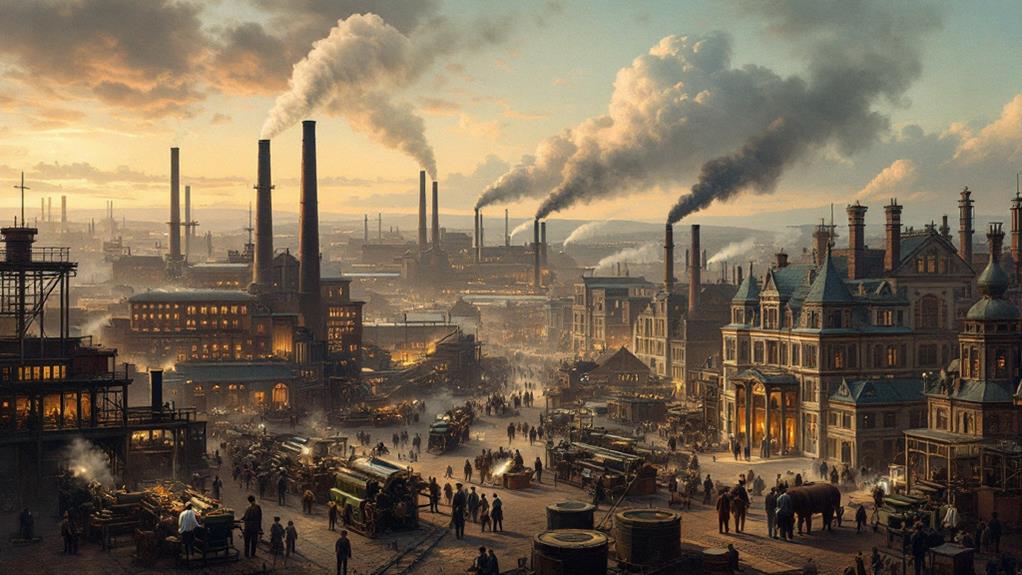The Richest People in Early American History: A Look Back

Investigate the wealth of early American tycoons like John D. Rockefeller, Andrew Carnegie, and Cornelius Vanderbilt. These men redefined riches during the Gilded Era with astonishing fortunes. Rockefeller, for instance, built an empire with Standard Oil, his wealth adjusted to around $400 billion today. Carnegie, famous for his steel empire and extensive philanthropy, amassed about $300 billion. Vanderbilt made his mark in railroads, reaching $236 billion. Their strategies, like monopolistic practices and philanthropy, shaped modern economic discussions. If you want to understand how their legacies continue to influence today's financial landscape, the stories of these industrial giants await.
Historical Wealth Perspectives
The Gilded Age's economic landscape shaped how we view historical wealth, as it was a time when colossal fortunes were amassed by individuals like Rockefeller, Carnegie, and Vanderbilt. During this period, the richest Americans became symbols of unprecedented wealth concentration. John D. Rockefeller stands out as the wealthiest American in history. His control over Standard Oil brought him an adjusted wealth of about $400 billion, illustrating the immense economic power wielded by a single individual.
Wealth distribution during the Gilded Period was highly unequal, with the top figures amassing fortunes that dwarfed those of their contemporaries. While Rockefeller's influence was mainly in oil, others like Carnegie dominated the steel industry. This time highlighted the disparity in wealth, which was often criticized for creating stark divides between the elite and the general populace.
Forbes' early 20th-century rankings exposed the concentration of wealth, with Rockefeller's fortune reaching $1.2 billion at the time. Wealth estimates today further underscore this disparity, with figures like Vanderbilt's wealth equating to approximately $236.4 billion. Understanding this historical wealth context is vital in grasping the foundations of modern economic structures and wealth distribution debates.
Prominent Wealth Figures
Exploring the figures who shaped early American wealth reveals not just the magnitude of their fortunes but also the industries that fueled their success. John D. Rockefeller, who founded Standard Oil, is often seen as the wealthiest American ever, reaching an estimated adjusted wealth of $400 billion. His dominance in the oil industry set a benchmark for business empires.
Andrew Carnegie, another titan, made his mark in the steel industry. With an estimated fortune of $300 billion, he later became renowned for his philanthropic ventures, donating over $350 million to numerous causes. His story epitomizes the rags-to-riches narrative, showing how industry acumen can lead to immense wealth.
Cornelius Vanderbilt carved his path through steamships and railroads, achieving a net worth of $236.4 billion. His investments laid the foundation for modern transportation networks, reflecting his foresight in infrastructure development.
John Jacob Astor initially thrived in the fur trade before pivoting to real estate, amassing $159 billion. At his death in 1848, he stood as America's richest man, illustrating the potential of diversified investments. These prominent figures showcase the distinct paths to wealth in early America.
Methods of Wealth Calculation

Determining historical wealth isn't just about tallying assets; it requires a nuanced approach that considers different factors. When you investigate wealth calculations for figures like John D. Rockefeller or Andrew Carnegie, you start by evaluating their total assets, including real estate, businesses, and investments. From there, you subtract any liabilities to determine net worth. But there's more than just numbers at play.
- Lifetime Donations: Consider the philanthropy impact. Rockefeller and Carnegie gave away massive fortunes, affecting their adjusted wealth figures and altering their legacy.
- Inflation Calculations: Without these, historical figures' wealth can't be accurately compared to today's standards. For instance, Rockefeller's $1.2 billion in 1918 is about $21 billion in 2017 dollars.
- Historical Wealth Rankings: Compilations like Forbes' 1918 lists help contextualize wealth within specific periods, highlighting how fortunes were amassed in banking and industry.
- Alternative of Wealth Accumulation: Adjusting for inflation can dramatically change a figure's perceived wealth over time. Carnegie's 1918 net worth of $200 million swells to $3.5 billion today.
In understanding these methods, you gain a deeper appreciation for how historical wealth was calculated, beyond just simple numbers.
Economic Influence of Wealth
Wealth, when concentrated in the hands of a few, profoundly shapes the economic landscape. Imagine living in a period where the wealthiest Americans, like John D. Rockefeller, held immense economic power. His empire, Standard Oil, dominated the oil industry, influencing market practices and even the U.S. economy. With a fortune equivalent to $253 billion today, Rockefeller's wealth once matched nearly half of U.S. Treasury holdings. That's a staggering level of influence, allowing him to shape economic policies and practices.
The economic power of these industrialists, including Carnegie and Vanderbilt, wasn't just about controlling industries like oil, steel, and transportation. It also impacted job creation and economic mobility. Their decisions affected countless lives, dictating the opportunities available to the average American. Yet, their influence wasn't solely economic. Rockefeller's philanthropic efforts, totaling $500 million in charitable donations, helped establish enduring educational and health institutions, benefiting public welfare and societal development.
During the Gilded Period, billionaires wielded significant sway over politics and economics, sparking debates on capitalism and ethics. Their actions shaped the economic landscape, leaving a legacy of wealth concentration and philanthropic endeavors that still echoes today.
Predictions on Wealth Trends

The legacy of wealth concentration among early American industrialists sets the stage for predicting future trends in wealth distribution. You can expect the concentration of wealth to rise with technological advancements. Industries like AI and biotechnology will likely birth new billionaires, shaping the economic landscape. Wealth inequality might widen, but there's potential for significant shifts in wealth distribution due to climate change's impact. This could present both challenges and opportunities for those focusing on sustainability.
Consider these emotional points:
- Rising Wealth Disparity: As tech billionaires emerge, wealth inequality could deepen, affecting societal harmony.
- Global Shifts: The geographic wealth distribution might change with globalization, expanding billionaire counts in emerging markets.
- Policy Impacts: Debates on wealth inequality could lead to policy changes, such as higher taxes on the ultra-wealthy, affecting wealth accumulation.
- Ethical Investments: With an emphasis on ethical investments, the wealthy might reshape their strategies, influencing their philanthropic endeavors and economic power.
In this evolving landscape, ethical investments and philanthropic endeavors will play significant roles, potentially transforming how wealth is perceived and utilized. You might witness a more conscientious approach to wealth management, affecting both personal and global scales.
Rockefeller's Wealth Legacy
In the late 19th century, John D. Rockefeller's wealth reshaped the American economic landscape. As the mastermind behind Standard Oil, Rockefeller transformed the oil industry. By 1880, his company controlled over 90% of the oil produced in the United States, setting unprecedented standards for quality. This dominance didn't just earn him the title of the initial billionaire in U.S. history; it secured him an adjusted fortune of $253 billion, marking him as the wealthiest American in history.
Rockefeller's wealth wasn't solely about amassing a fortune. His philanthropic efforts were similarly groundbreaking. He founded the University of Chicago and the Rockefeller Foundation, through which he donated over $500 million—equivalent to about $8 billion today. These contributions demonstrated his commitment to using his wealth for societal benefit.
Despite the 1911 breakup of Standard Oil for monopolistic practices, Rockefeller's legacy continued to influence the industry. This led to the creation of major oil companies like ExxonMobil and Chevron, which still play significant roles today. Rockefeller's wealth legacy is not just a tale of unprecedented fortune but also of transformative philanthropic impact and enduring industrial influence.
Early Wealth Rankings

Starting in 1918, Forbes initiated the initial extensive wealth ranking in America, shedding light on the immense fortunes of prominent industrialists. This groundbreaking list showcased the staggering wealth amassed during the industrial age. Topping the list was John D. Rockefeller, whose net worth of $1.2 billion was a monumental figure, equivalent to $21 billion in 2017 dollars. His wealth was so vast that, if distributed, it could give every American around $10 at the time.
The ranking painted a vivid picture of the richest individuals, their fortunes primarily rooted in critical industries like oil, steel, and banking. Here's a glimpse of the early wealth landscape:
- John D. Rockefeller: The wealthiest, with $1.2 billion, his oil empire set a precedent for future tycoons.
- Andrew Carnegie: With $200 million, his steel empire was a cornerstone of American industry.
- Henry Clay Frick: Amassed $225 million, reflecting the age's industrial might.
- Wealth Concentration: Highlighted the disparity, with fortunes concentrated among a few.
These early wealth rankings were more than just numbers; they symbolized the economic power and influence wielded by a select few, shaping America's financial landscape.
Philanthropy and Social Impact
Turning from the staggering fortunes amassed during America's industrial age, one might wonder how these wealthy figures chose to use their wealth beyond personal gain. Philanthropy played a crucial role in shaping their legacies. John D. Rockefeller, with an estimated wealth of $400 billion, channeled a substantial portion into charitable contributions, founding the Rockefeller Foundation and donating over $500 million to numerous causes, equating to about $8 billion today. His philanthropy had a lasting social impact, particularly through the establishment of the University of Chicago, which continues to be a leading research institution.
Andrew Carnegie, another titan of wealth with $300 billion, accepted the "Gospel of Wealth," advocating for the rich to contribute to societal betterment. He donated approximately $350 million, focusing on educational institutions and libraries, helping to democratize knowledge and education. Meanwhile, George F. Baker's $5 million donation to Harvard Business School in 1924 underscores the trend of investing in education for societal development.
Stephen Girard also used his wealth for social impact, financing the U.S. Government during the War of 1812 and directing a significant portion of his fortune to charitable causes, ensuring his legacy endured through philanthropy.
Industrial Contributions and Innovations

Amidst the clamor of early American industry, titans like John D. Rockefeller, Andrew Carnegie, Cornelius Vanderbilt, and Jay Gould left indelible marks. Rockefeller transformed the oil industry by founding Standard Oil. By 1880, he controlled 90% of U.S. oil production, setting standards for lamp oil quality. His vision turned oil into a cornerstone of American industry.
Next, you have Andrew Carnegie, who reshaped the steel industry. By implementing creative production methods, he enhanced efficiency and advocated for the "Gospel of Wealth," urging the rich to use their fortunes for the greater good.
Cornelius Vanderbilt, a railroad tycoon, was crucial in shaping America's logistics. By building a vast network of railroads and steamships, he connected the nation like never before.
Jay Gould, another railroad tycoon, used aggressive tactics to expand the U.S. railroad system during the Gilded Period.
This timeframe wasn't just about wealth; it was about transformation. Imagine the excitement:
- The roar of trains knitting the country together.
- The clink of steel framing cities.
- The glow of lamp oil brightening homes.
- The hum of industry shaping American History.
These advancements forged modern America, sparking ingenuity and progress.




